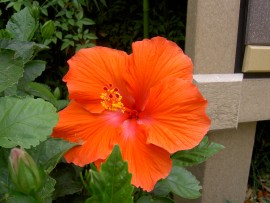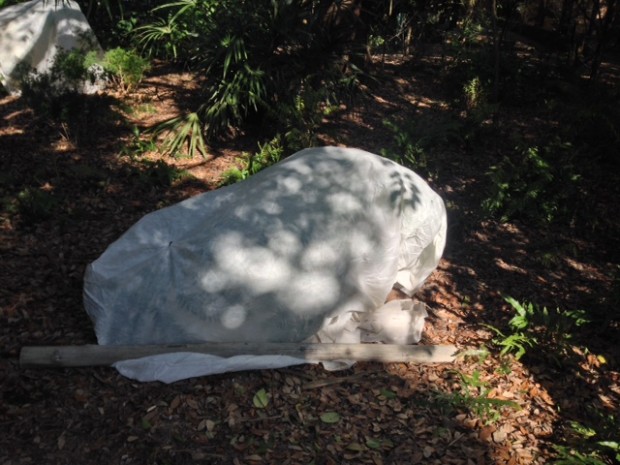Freeze Protection for Plants
Written by Anna Land, AZH Certified Zoo Horticulturist & Houston Zoo Horticulture Supervisor
The Horticulture department at the zoo cares for 55 acres that are covered with a very diverse collection of plants, which makes winter protection a team effort. We’ve been keeping our eyes on the forecast and have made sure that we’re ready with frost cloth when the time comes, which looks like it may be this weekend. With the possibility of a freeze tonight, I’ve had several staff and Zoo Members ask me the best way to protect their plants at home. So I thought I’d share some information on freeze protection.
 Here in Houston, we’re able to grow many tropical plants which have not evolved to deal with freezing temperatures. For them, when temperatures get down to freezing, ice crystals will form in the cells within the leaf. These crystals pierce the cell walls of the plant, as the temperatures rise and the ice melts, holes are left in the cell walls causing the fluid to leak. This results in the mushy tissue you see after temperatures warm up.
Here in Houston, we’re able to grow many tropical plants which have not evolved to deal with freezing temperatures. For them, when temperatures get down to freezing, ice crystals will form in the cells within the leaf. These crystals pierce the cell walls of the plant, as the temperatures rise and the ice melts, holes are left in the cell walls causing the fluid to leak. This results in the mushy tissue you see after temperatures warm up.
To prevent this, you want to keep the temperature around the plant above freezing. There are several methods that can be used, but the easiest way to do this is to make the radiant heat coming from the ground work for you. Properly covering a plant with frost cloth or a sheet* will trap that radiant heat and hold it around the plant, keeping it above freezing in most cases. Extended freezes or extreme cold may require additional methods to be used, but when temperatures stay around 32⁰F during overnight hours, covering is sufficient. To properly trap the heat you must bring whatever covering you’re using all the way to the ground and secure it so that you don’t have cold wind blowing through and pushing warmer air out. This can be done with rocks, stakes, turf staples, or even toys the kids left in the yard… whatever is small enough to move and heavy enough to withstand wind. Potted plants can be covered in the same way, moved into a garage or covered area, or even moving them up against the house and giving them a good watering will help.
Driving around town over the years I have seen many trees wrapped like lollypops, this does not trap radiant heat and doesn’t do much for your tree other than turn it into yard art. If you have a newly planted tree that the crazy weather has caused to start pushing out new leaves and you want to protect them, you can wrap your tree like that, but you will need to provide a heat source inside that covering. An example would be outdoor rated incandescent tree lights, but make sure you follow all recommended safety guidelines; you don’t want to turn your tree into a candle.

A quick note about frost cloth vs. sheets: Frost cloth was originally designed for production agriculture, so it’s designed to trap the heat and allow light through and won’t absorb water. This allowed those growers to cover their plants and leave them covered, saving time and labor costs. This means that if you’re using frost cloth and the forecast calls for multiple nights with freezing temperatures, you can leave your plants covered for extended periods of time. On the other hand, if you are using sheets to cover your plants, you will need to uncover them during the day once temperatures have risen above freezing. There are a couple of dangers with leaving sheets over plants for extended periods of time: 1) the plant may not get enough sun light; 2) if the sheet gets wet it could provide conditions for fungal/pest problems; or 3) it could get warm enough underneath to encourage the plant to start growing at the wrong time.
*I don’t recommend using plastic sheeting unless it’s on some sort of framework preventing it from touching the plant. Laying it directly on a plant can still allow freeze damage and if not removed as temperatures warm, can “cook” your plant as it accumulates the heat from the sun.
